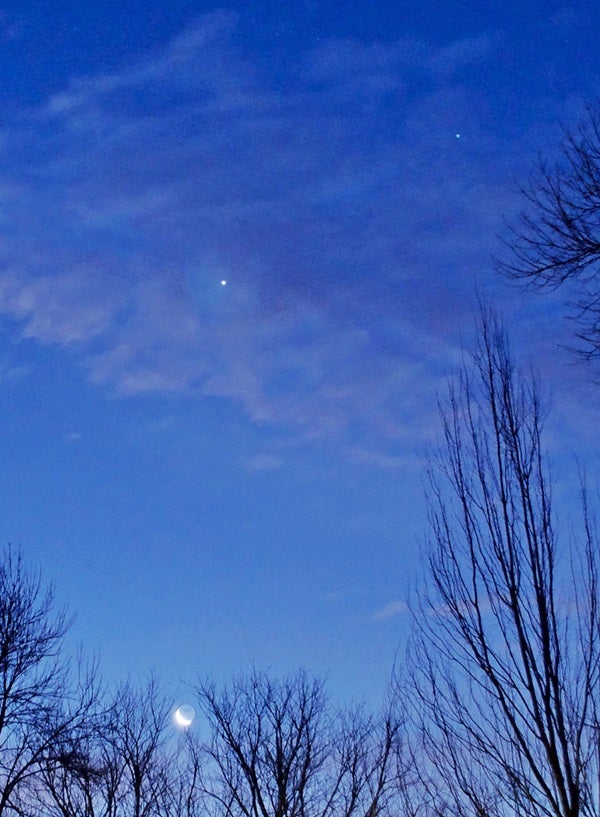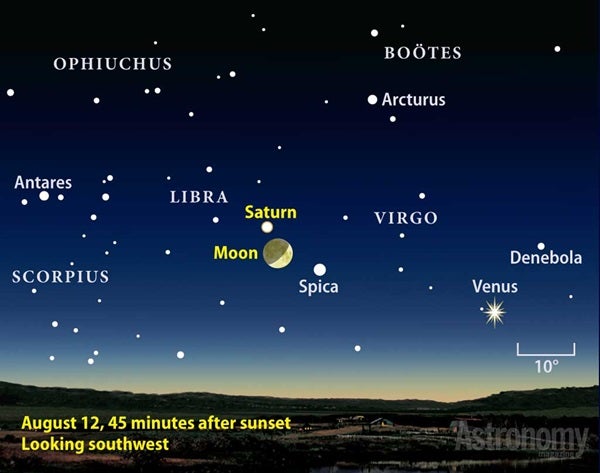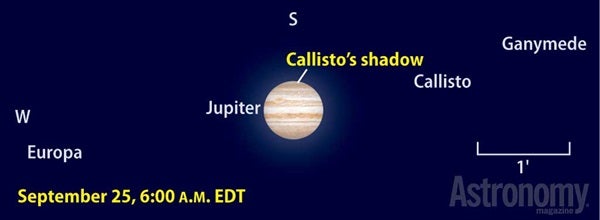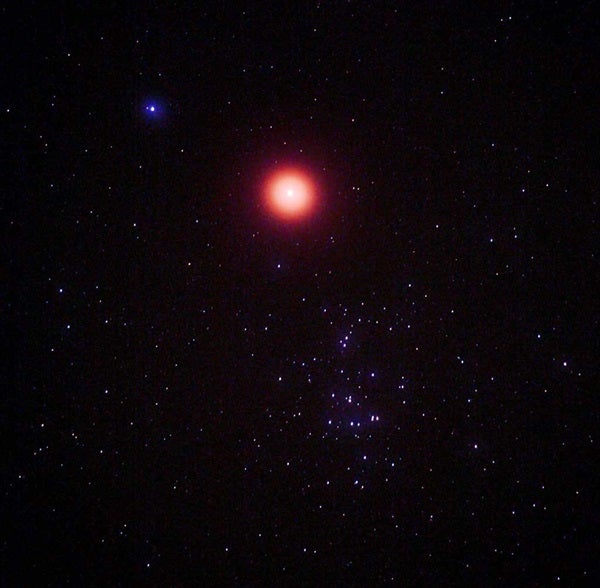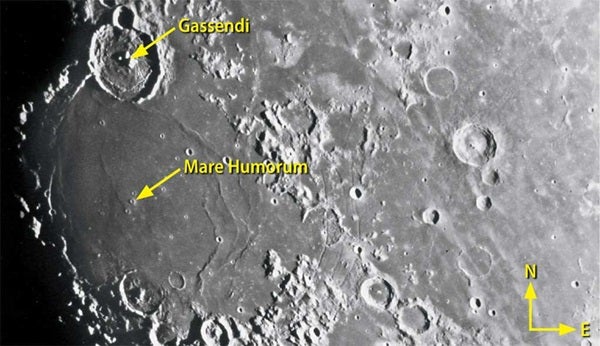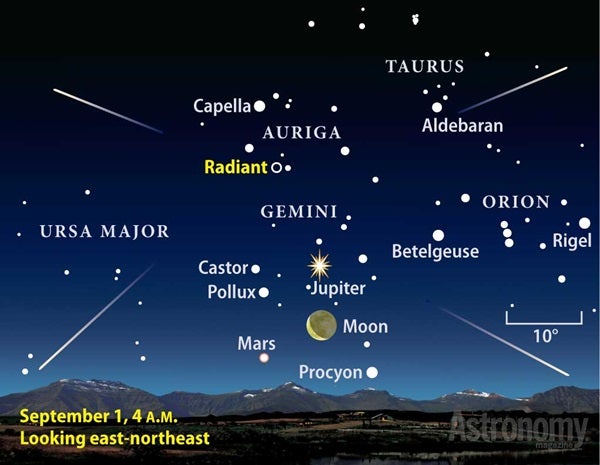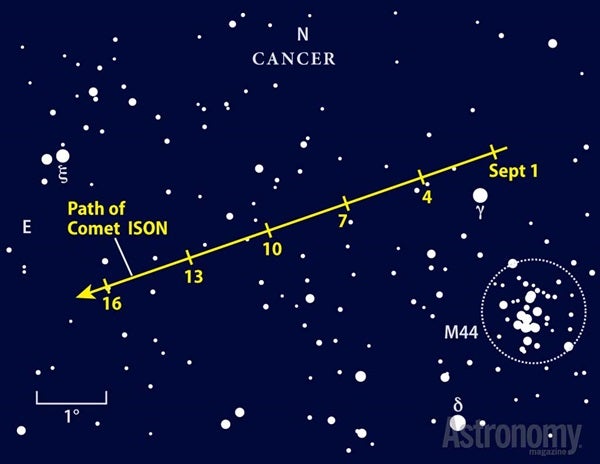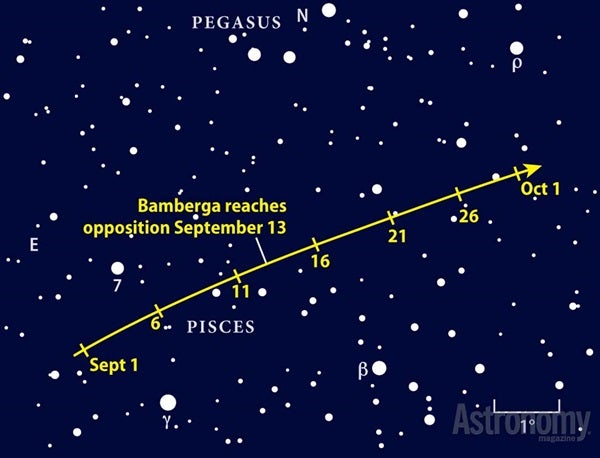The overnight hours see Uranus and Neptune near their best. The former will come to opposition and peak visibility during October’s first week, while the latter reached the same configuration in late August. September’s predawn hours feature excellent views of Jupiter and the passage of Mars through the Beehive star cluster (M44).
People at mid-northern latitudes will be hard-pressed to find Mercury in evening twilight this month. That’s because the ecliptic — the apparent path of the Sun across the sky that the planets also follow closely — makes a shallow angle to the western horizon after sunset at this time of year. Although the inner planet’s elongation from the Sun increases substantially during September, most of that angle translates into distance along the horizon and not into altitude.
Perhaps the best night to search for Mercury is September 24, when it passes just 0.8° north of the bright star Spica in Virgo the Maiden. The planet then shines at magnitude –0.1, about 2.5 times brighter than Spica. This is the closest passage of any planet to a 1st-magnitude star during 2013.
As a guide to the pair, draw an imaginary line from Venus toward the point where the Sun set. Sweep this area with binoculars about a half-hour after sundown. At 40° north latitude, Mercury sets just 15 minutes later. The best views will come from observing sites with flat, unobstructed western horizons.
Three days later, the waxing crescent Moon joins this pair to create a lovely twilight scene. The Moon passes just 0.4° south of the planet at 5 p.m. EDT. By the time darkness starts to fall in North America, the two appear between 1° and 2° apart, with Spica 3.6° west of Venus.
That same evening, magnitude 0.7 Saturn lies 11° east of Venus. Because the ringed world dwells in the outer solar system, it orbits the Sun more slowly than Venus and thus moves eastward against the background stars at a more leisurely pace. So, each night these two planets appear closer together. Venus crosses from Virgo into Libra on September 18; on the following night, the sparkling gem passes 4° south of Saturn.
The two then separate as September draws to a close. By the 30th, Saturn appears 13° northwest of Venus, with Mercury (still mired in bright twilight) some 9° west of the ringed planet.
Both Venus and Saturn are worth targeting through a telescope. Their low altitudes mean clear views will be harder to come by than normal, but you’ll be rewarded for your effort. Venus’ apparent size grows steadily during September while its gibbous phase wanes. On the 1st, the planet appears 15″ across and 74 percent lit; by the 30th, the disk spans 18″ and the Sun illuminates 64 percent of it.
Neptune reached opposition August 26 and appears just as nice in September as it did then. Even better, it lies higher in the evening sky. At midmonth, you can find the outer world nearly 30° high in the southeast around 9 p.m. local daylight time. It peaks nearly halfway to the zenith above the southern horizon shortly before midnight.
As befits the planet named after the Roman god of the sea, Neptune this month floats among the background stars of Aquarius the Water-bearer. Because it glows at magnitude 7.8, you’ll need binoculars or a telescope to locate it. In early September, you can track it down 1.9° due west of 5th-magnitude Sigma (σ) Aquarii. By month’s end, the planet’s westward motion has carried it 2.6° away from the star. A telescope at high magnification reveals Neptune’s blue-gray disk, which spans 2.4″.
Trailing one constellation and about two hours behind Neptune, Uranus lies against the backdrop of Pisces the Fish. In mid-September, it appears in the eastern sky by mid-evening and climbs highest in the south around 2 a.m. local daylight time. You can spot the planet through 7×50 binoculars from the suburbs and with naked eyes under a dark sky if you exercise some patience. Look for Uranus south and a little west of 4th-magnitude Delta (δ) Piscium. The gap between star and planet grows from 3.9° to 4.7° during September.
Although this ice-giant world won’t reach opposition until October 3, it glows just as bright (magnitude 5.7) this month as it will at its peak. Likewise, it looks the same through a telescope during September as it will at opposition. At moderate magnification under steady sky conditions, the planet’s 3.7″-diameter disk shows up easily, as does its distinct blue-green color. For more information about observing Uranus, Neptune, and their moons, see “Prime time for Neptune and Uranus” in the August Astronomy.
Expect magnificent views of Jupiter through your telescope in the solitude of September’s predawn hours. Early autumn often delivers exceptionally steady skies, which make planetary details stand out. The giant world’s disk grows from 35″ to 38″ across this month and should show plenty of atmospheric features. Look for two prominent dark belts, one on either side of a brighter equatorial zone, as well as more subtle swirls, spots, and plumes.
Four bright moons orbit effortlessly around Jupiter, providing an ever-changing pattern first recorded four centuries ago by Galileo Galilei’s keen eye and new telescope. Watching these satellites and their shadows transit the jovian disk can provide hours of enjoyment.
One such event stands out in September. On the morning of the 25th, outermost Callisto casts its giant shadow onto Jupiter’s south polar region. This is the moon’s first shadow transit visible from North America since 2010. The event begins at 5:15 a.m. EDT and lasts two hours and 10 minutes. Look carefully and you might notice that the shadow appears elongated because the planet’s polar regions curve sharply away from us.
Although far less prominent than Jupiter, Mars still looks conspicuous on September mornings. The Red Planet appears low in the eastern sky by 4 a.m. local daylight time and climbs significantly higher by the time twilight begins. It shines at magnitude 1.6 all month and stands out thanks to its ruddy hue.
Although Mars begins the month against the relatively bland backdrop of western Cancer, it soon moves into a much splashier neighborhood — on September 8 and 9, it flits through the beautiful Beehive star cluster (M44). Binoculars or a wide-field telescope will provide the best views of this impressive alignment. Most amateur scopes, however, won’t show any detail on the planet’s tiny 4″-diameter disk. Mars crosses into Leo on September 26 and ends the month 9° shy of 1st-magnitude Regulus, the Lion’s brightest star.
The waxing gibbous Moon is chock full of interesting sights. Take in Tycho’s long rays, the large expanse of Mare Imbrium, and the inviting splatter that surrounds the crater Copernicus. You even can start observing the Moon before dark, when the blue sky reduces its glare. At night, our satellite appears remarkably bright through a telescope. Use a filter, an aperture mask, or even wear sunglasses to cut down the glow.
On the evening of September 15, a few days before Full Moon, the sunrise line has advanced just past the fascinating crater Gassendi. It sits on the northern edge of modest Mare Humorum (the Sea of Moisture) in the lunar southwest. Formed by a giant impact eons ago, circular Gassendi measures 68 miles across. Its southern flank tilts down toward Mare Humorum’s center.
Characteristic of large craters, Gassendi has multiple peaks at its center and debris at the base of its mountainous rim where material “slumped” off the walls. You can see how the prominent crater on the northern rim formed afterward and pushed this debris inward. The arcs and rilles inside Gassendi’s main ring to the south and southeast are remnants from when the floor fractured early in its history as the lunar crust moved up and down, causing cracks like you might find on a pie crust. Lava welled up from beneath and covered half of Gassendi’s floor.
The crater’s namesake is astronomer and theologian Pierre Gassendi of France. A contemporary of Galileo and Kepler, he supported Copernicus’ heliocentric theory. In 1631, Gassendi was the first person to observe Mercury transit the Sun.
Traditionally, September is a quiet month for meteors. No major showers occur, and only two rise to the level of minor shower (and those just barely). The one to keep an eye on this month is the Aurigids, which peak before dawn September 1.
This shower typically produces a maximum rate of six meteors per hour, but that number assumes the radiant (the point in the constellation Auriga from which the meteors appear to emanate) lies overhead and you’re observing under skies dark enough that you can see magnitude 6.5 stars. Observed rates almost always fall below this maximum.
But the Aurigids occasionally burst out of their usual lethargy. Rates six times higher than normal occurred in 1935, 1986, and 1994, and observers recorded up to 130 meteors per hour in 2007. Although no one knows when the shower will shine again, this year’s waning crescent Moon provides minimal interference for viewers to check it out.
| WHEN TO VIEW THE PLANETS |
||
| Evening Sky |
Midnight | Morning Sky |
| Mercury (west) |
Uranus (southeast) |
Mars (east) |
| Venus (southwest) |
Neptune (south) |
Jupiter (east) |
| Saturn (southwest) |
Uranus (west) |
|
| Uranus (east) | |
|
| Neptune (southeast) | |
|
Given the potentially historic appearance of Comet ISON (C/2012 S1), many amateur astronomers are keen to follow it from infancy. Join them as it brightens into the range of 8- to 10-inch scopes in early September and perhaps half that aperture by month’s end. Because the comet approaches Earth from the morning side, you’ll need to view it about two hours before sunrise. Grab a nap if you can — it’s tough to see subtle details when you’re sleep-deprived. As a bonus, you’ll be really dark adapted!
ISON lies low in the east before dawn, just north of the hazy glow of the Beehive star cluster (M44) in Cancer during early September. That nearby bright orange “star” is actually the planet Mars. If you’re at a really dark site, you should see a soft pyramidal glow extending up from the horizon. This is the zodiacal light, or the “false dawn.” Take advantage of the Labor Day weekend to bag ISON because light from the waning gibbous Moon will hinder views after midmonth.
Use the finder chart to zero in on the dirty snowball’s position. You may not see anything at first, so pump up the power to 150x or so. At this early stage, ISON will be only a couple of arcminutes across and likely glowing between 10th and 12th magnitude. We’re viewing ISON at an angle, so it ought to appear slightly out of round, with a sharper edge in the direction of the Sun and a more diffuse opposite side where a nascent tail is forming. For more details on observing this visitor, see “Get your first peek at Comet ISON” on p. 50.
As a warm-up to comet viewing, look at NGC 2976 and NGC 3077 — the brighter companion galaxies to M81 and M82 in Ursa Major. Early this month, ISON should look similar to them; next month, the comet should rival the brightness of the Messier galaxies themselves.
September offers a great chance to spy a high-numbered asteroid. Asteroid numbers reflect their order of discovery, and bigger and brighter objects naturally tended to come earlier. But 324 Bamberga has a diameter of around 140 miles, making it bigger than half of the first 10 asteroids. Its elliptical orbit brings it as close to Earth as it can get this month.
Bamberga peaks at magnitude 8.1 when it reaches opposition September 13. It will be relatively easy to track down against the fainter background stars of Pisces the Fish. Wait until mid-evening for this area of sky to climb above the rooftops, trees, and any haze. Also avoid the few nights around Full Moon on the 19th.
Your target will be among the brightest points of light in your telescope’s field of view. If you enjoy the dynamic aspect of the sky, record the positions of the dots with a quick sketch and return a night or two later to confirm which object moved.
The next time Bamberga and Earth line up this closely will be in 2035, so search for it now. Austrian astronomer Johann Palisa discovered the asteroid in 1892, 91 years after Giuseppe Piazzi found 1 Ceres. The gap is not too surprising when you realize that the best windows of opportunity open only every 22 years.
Martin Ratcliffe provides planetarium development for Sky-Skan, Inc. from his home in Wichita, Kansas. Meteorologist Alister Ling works for Environment Canada in Edmonton, Alberta.

